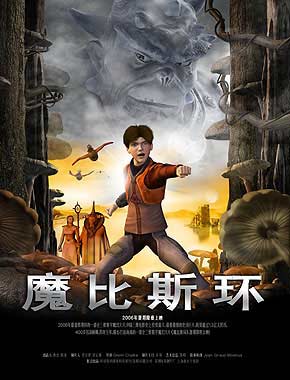| Tools: Save | Print | E-mail | Most Read |
| Narratively Imaginative |
| Adjust font size: |
Hopes are high for Thru the Moebius Strip, set for release in August. This first 3D animation film made in China could potentially jump-start the industry. Moebius Strip - making a movie about twisted paper?
Thru the Moebius Strip, the first made-in-China full-length 3D animation film, is based on noted French comic artist Jean Giraud's concept.
Thru the Moebius Strip, the first made-in-China full-length three-dimensional animation film based on a concept by Jean Giraud, a noted French comic artist, looks set to not only reap big profits at the box office, but also ring a clarion call for the renaissance of Chinese animation industry. However, this is not an easy job, as this year's summer screen has already featured a number of animation elements, from the full-version puppet animation Xiyue Qitong (Saving Mother) to Superman Returns and Dragon Tiger Gate, adapted from Hong Kong's comic hit. Chen Ming, art designer of Moebius, is still optimistic that the film, which is set to hit screens nationwide on August 4 will be a special visual and audible joy for local audiences. "We have spent five years making this CG (computer graphics) saga," Chen says. "You know, 3D animation is a hot genre for many A Moebius Strip is a geometric loop with just one surface and one edge. It can easily be made with a strip of paper by twisting it once, then taping the ends together. Thru the Moebius Strip had a budget of around US$18.8 million from the Institute of Digital Media Technology (Shenzhen) Ltd, part of which went to its acclaimed international crew. The film is based on an idea by legendary French graphic novelist and Giraud creatively incorporates the Moebius Strip in the story as a space-time tunnel, which enables Jac, the 14-year-old hero, to rescue his physicist father, Simon Weir, and conquer the evil emperor on the alien planet. Bringing even more "We needed a 'global' story that will work around the world," Chen says, adding that the global market is exactly what they're aiming at. More than 400 domestic and international cartoon professionals were involved in the 3D CGI animation. The experienced crew also included producer Frank Foster, former vice president of multimedia at Sony Pictures Imageworks; director Glenn Chaika, who was an effect animator on The Little Mermaid and who directed Tom Thumb and Thumbelina; and modeling supervisor Wayne Kennedy, who played a part in the production of Star Wars, The Mummy and Men in Black. Mark Hamill, who played the famous role of Luke Skywalker in the first Star Wars trilogy, lent his voice to the production, playing Jac's father in the original version in English. "To compete on the international scene, what we need is not only endless imagination, but also a mature and successful mode of storytelling," Chen adds. "That's why we have invited so many In addition, some Oriental elements such as kung fu and traditional costume and music have been added to give the epic film a little Chinese feel, a technique that the crew picked up from Japanese animation master Hayao Miyazaki. How Moebius will perform at the local box-office is anybody's guess. "The story seems so fresh to the local people," says Zhang Jian, an animation fan. "Actually it is the entertaining storylines and distinctive images that largely contribute to the success of Now the producers are busy seeking overseas distributors to organize an international release of the film, following the footsteps of other successful Chinese productions such as Hero and The Promise. "In fact, making a film always involves some regret," Chen adds. "We could have done better on the animation. But such an experience is quite rewarding for domestic cartoonists who can learn a lot from their foreign peers." The global cartoon and comic industry is worth an estimated US$200-500 billion a year. It is definitely true that Thru the Moebius Strip, no matter how well it performs in the market, will be an impetus for the local cartoon industry. All on the way are also some by-products of the film, including toys, novels, comics, photo albums, accessories and computer games. "We want to see our own comic industry thrive," says the 30-year-old comic fan Steven Qian. "Actually we need big domestic animation studios like Disney and Pixar. These are more than just production houses. They also oversee every aspect of the process, including production, marketing, promotion and distribution." What is Moebius strip A Moebius strip, named after German mathematician August Ferdinand Mobius (1790-1868), is a continuous one-sided surface that can be formed from a rectangular strip by rotating one end 180 degrees and attaching it to the other end. It is the subject of many mathematical mindbenders and puzzlers. In the film it is a multi-dimensional pathway used to rescue the protagonist's magically enchained father. (Shanghai Daily July 13, 2006) |
| Tools: Save | Print | E-mail | Most Read |
 |
| Related Stories |
|
Product Directory China Search |
Country Search Hot Buys |
